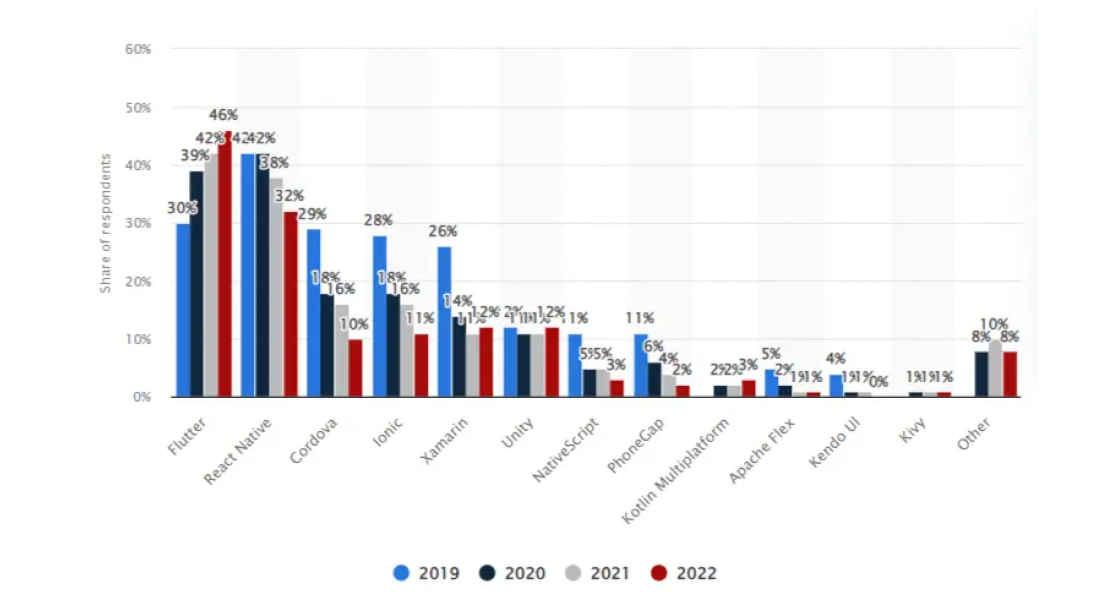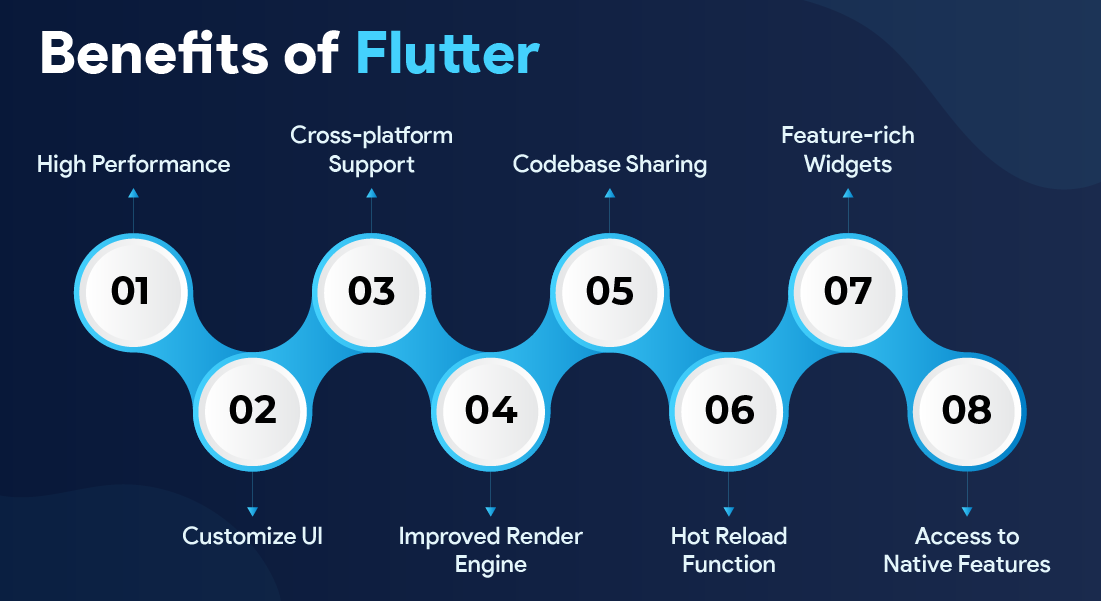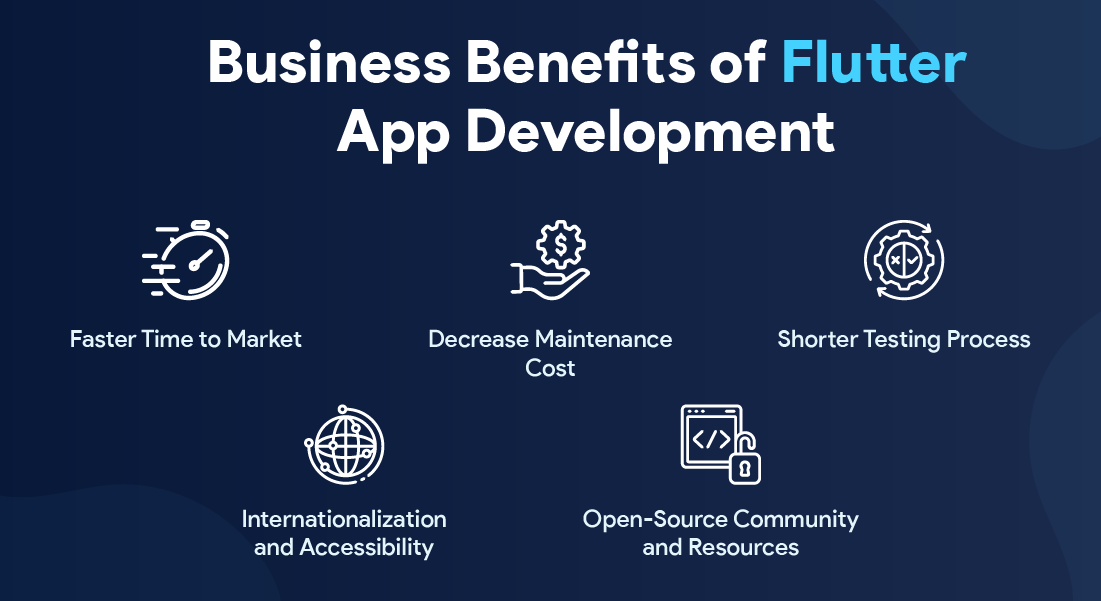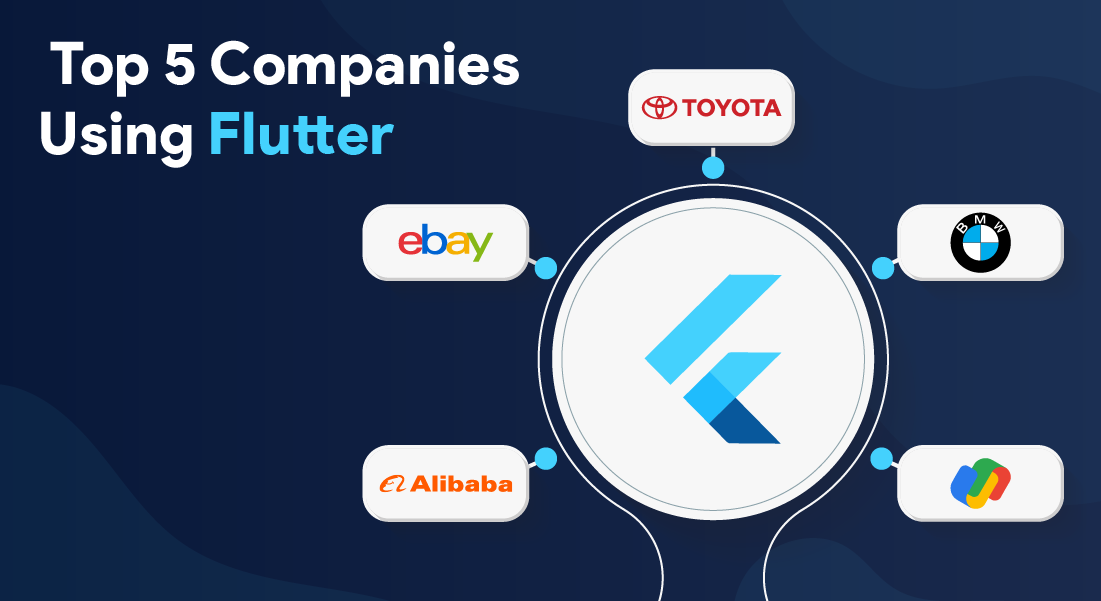Quick Summary:
Flutter is an evolving frontend framework that has stolen the spotlight for several reasons because of its high performance and scalability. Flutter is a cross-platform that can efficiently be implemented on mobile, web, and desktop. In this comprehensive guide, we will discuss the benefits of Flutter to understand why it is one of the most sought-after open-source UI software development kits, empowering many business apps.
Table of Contents
Introduction
Flutter is popular not because it is open-source or developed by Google, but because of its substantial features like hot reload, high performance, customized widgets, faster development, and expressive UI. Flutter’s features empower developers to create excellent cross-platform applications with engaging performance and stunning visual displays.
According to Statista, 46% of software developers use Flutter to develop cross-platform applications. Its popularity isn’t just hype, but it is backed by some impressive reasons and interesting facts that we will discuss ahead. Since Google launched it in 2017, its developer community has increased by 3x over the years. As of now, more than 4 million developers globally use Flutter.

Do You Know?: Flutter apps consistently rank high on app stores. In Q3 2023, 3 out of the top 10 downloaded apps in China were built with Flutter.
What is Flutter?
Flutter, a front-end framework developed by Google, is an open-source software that serves as a versatile and dynamic development kit for creating apps. It is widely known for its compatibility with both iOS and Android platforms, making it a popular choice among developers. Flutter is often used in conjunction with Dart, an object-oriented programming language also developed by Google.
What sets Flutter apart is its ability to create applications across platforms such as iOS, Android and even web browsers like Fuchsia, Linux, Windows, and macOS using one codebase.
Although initially released in 2015, Flutter remained in beta until the end of 2018, when it officially launched its version, Flutter 1.0. This release introduced Dart as the programming language. Since then, Flutter has undergone advancements. It has gained widespread popularity worldwide. In fact, according to a survey conducted among developers, 35% utilize Flutter for startups, while 26% implement it for business software solutions.
Flutter includes two crucial components:
1. Software Development Kit (SDK): The kit provides libraries and tools to develop a Flutter application. It includes Dart, an object-oriented programming language, rendering, command-line tools, and widgets. SDK puts user interfaces first.
2. Framework: It defines the structure and architecture of your application, including the user interface. State management, routing, and pre-build widgets are essential for the Flutter framework. In all, it is a framework with a cohesive collection of widgets that can be customized according to specific requirements.
The cherry on the top is that Google continues investing in Flutter, ensuring its long-term viability. They keep adding the latest updates, making Flutter valuable and innovative for developers to create robust applications. As a result, it signifies credibility and reassurance to the business owner as the future-oriented framework. According to Statista, Flutter took over React Native in 2022 to become the #1 cross-platform mobile app development framework.
Do You Know?: The name “Flutter” was inspired by the idea of butterflies, representing the framework’s lightness, flexibility, and ability to adapt to different environments.
Top 8 Benefits of Flutter to Empower Your Business
Flutter has its unique advantages compared to other cross-platform technologies and native platforms. Here is a list of powerful benefits of Flutter that can enhance business efficiently and effectively.

1. High Performance
Due to the single codebase and native app-like performance, Flutter delivers high performance and a streamlined user experience that enhances the overall productivity, functionality, and stability of an application. It targets to provide 60 frames per second (fps) or 120 fps performance, which indicates higher mobile responsiveness.
Moreover, Flutter compiles the code into native ARM machine code for higher performance and UI rendering. In addition, implementing pre-designed widgets and a rich ecosystem offers smooth animations and faster responsiveness.
2. Customizable UI
You need a framework that offers seamless user interfaces regardless of application type, and Flutter is that solution. The framework provides excellent and customizable UI widgets that help to generate intuitive and visually appealing user interfaces. It has pre-build widgets, including text fields, switches, and buttons suitable for iOS and Android platforms.
The core advantage of customization is that you can make changes in real-time and control the look and feel of the app’s user interface. Additionally, altering screen size, performance, and user experience regardless of complexity becomes easier in Flutter due to the customizable UI.
Hire Flutter developer from us who is proficient in designing and tailoring user interfaces as per your requirements
3. Cross-platform Support
One of the crucial factors for choosing Flutter is its cross-platform support. Flutter uses Dart programming language, which allows you to utilize the same code for iOS and Android platforms. As a result, you do not have to do even minor code changes while operating for different devices.
Besides, with a single codebase and customized widget, the developer gains control to modify and determine the application’s look, feel, and performance. Meanwhile, it increases the possibility of combinability in terms of application performance.
4. Improved Render Engine
Flutter has a render engine called Skia that does not require any platform-specific UI components to create engaging graphics and beautiful animations. Whether the application is complex or large-scale, Flutter ensures it is visually appealing and runs smoothly with minimum resource consumption. As a result, you can build creative and appealing visualizations for both Android and iOS platforms, from vibrant colors in iOS to pixels in Android.
Moreover, you can implement both material design for Android and the human interface of iOS. In addition, with the help of Flutter, you can include high-resolution visuals and compelling displays in an application, thereby enhancing user experience and interfaces.
5. Hot Reload Function
Flutter’s hot reload function has a massive fan base because of its ability to change code instantaneously. It allows developers to view the real-time changes in the code without restarting the entire application; hence, you can make quick changes and are prone to fewer errors.
The hot reload is a powerful Flutter tool that solves user interface problems during the development phase. On top of that, an average hot reload time in Flutter takes less than 8 seconds to perform, which shows how efficient and faster the framework process is.
6. Feature-rich Widgets
Flutter has an extensive collection of widgets that enhance applications with excellent features. Plus, these widgets are customizable and toggle drag-and-drop options; it also includes features like push notifications, chats, animations, and a Flutter theme like light/dark mode.
Moreover, implementing Flutter feature-rich widgets makes it easier for you to handle large amounts of data and adapt backend requirements. With the help of widgets-based architecture, you can add the latest features and develop a scalable application.
7. Future-proof and Adaptability
The demand for Flutter has seen a steep increase due to its contribution to the application’s advancement. Flutter is a prominent front-end framework that is flexible, agile, and scalable. Besides, it is highly compatible with other leading backend or frontend technologies.
More likely, the demand for using Flutter in developing mobile apps and web apps is going to increase in the future. Because of its extensive functionality, Flutter isn’t just for today’s screens. Its flexible architecture makes it perfectly suited for emerging technologies like foldable phones, wearables, and even web and desktop apps.
8. Access to Native Features
Not every business can afford to have progressive web applications and advanced mobile applications. Flutter is their solution, to achieve native app-like performance if Flutter performance optimization is done right. Best of all, building a robust app is free, convenient, and scalable.
The Flutter applications were developed with machine code, eliminating performance issues and other severe bugs. Hence, native features contribute to benefits in Flutter applications. Flutter compiles directly to machine code, resulting in blazing-fast native apps that feel as smooth as butter on both Android and iOS. No more compromises on performance or user experience.
5 Benefits Achieved by Businesses Through Flutter App Development

Flutter is a robust framework that speeds up web, mobile, and desktop application development using a single codebase. So, is Flutter the secret weapon for a successful business? Here are reasons that justify why use Flutter and empower your business with productive apps.
1. Faster Time to Market
A survey shows an average of 1,642 new applications are daily released on Google Play. It signifies how crucial it is to launch an application on time and faster. As a result, implementing Flutter is beneficial for any business as it provides rapid development.
The benefits of Flutter are that it requires half the time to build applications because of cross-platform support. A developer doesn’t need to write platform-specific codes, which helps in saving their time and resources.
Team Up With Our Flutter App Development Company to Transform Your App Ideas into Market-Ready Products Swiftly
2. Decrease Maintenance Cost
Flutter is cross-platform, allowing developers to use the same codebase on every platform. It saves testing and maintenance time as you do not have to invest separately in iOS and Android platforms. Besides, while managing or modifying changes, you will be able to perform it from a single resource or in a single codebase.
Moreover, you eliminate the requirement of writing code from scratch, saving time and the developer’s efforts. In addition, you can hire dedicated developers to upgrade or develop different applications, which helps you save time, costs, and resources.
3. Open-Source Community and Resources
Though Flutter is a comparatively new framework compared to others, it has a strong, growing community of developers and consultants who can help you create robust apps. The benefits of Flutter are that it is a free, open-source platform, and its growing community contributes efficient documentation that solves several issues.
According to the JetBrains 2021 State of Developer Ecosystem survey, Flutter has 155k Stars on GitHub, 240k Followers on Twitter, and 175k Members on Meetup. As per the study, Flutter developers are in demand because of full-stack development and the versatility of operating applications with one codebase. Thus, you can seek a proficient Flutter developer with skills for your resource use.
4. Internationalization and Accessibility
Flutter is one of the leading technologies among front-end developers. If we talk globally, over 40% of software developers have preferred Flutter for building applications in the last three years. Flutter’s focus on i18n and a11y makes it the perfect choice for developers who want to build apps that are inclusive, global, and reach their full potential.
In addition, it is easily accessible because of its Minimum Viable Product (MVP). Flutter also supports accessibility, including screen sizes, font text, multiple language support, and display contracts. Additionally, it automates features within the platform.
5. Shorter Testing Process
Consider your developer is using multiple technologies for different purposes and platforms. Each development process is time-consuming, which leads to more money and resources. However, the case is different for Flutter, as it allows you to make changes instantly and use a shareable codebase.
It also indicates a minimized and simplified testing process, allowing you to focus on other issues of the development stage. Moreover, the chances of platform-specific problems decrease and facilitate quick releases along with consistent user experience.
Do You Know?: As of now, Google Play Store has approximately 3.718 million mobile apps and one in five new apps on the Play Store use Flutter.
Top Companies Thriving Businesses Using Flutter

Flutter is a successful ingredient that numerous leading companies have added to their application. Let’s take a glimpse of how Flutter has been beneficial for various companies. Here is the listing of thriving companies that have availed benefits of Flutter development to enhance their business:
1. Alibaba
First on the list is the giant eCommerce market, Alibaba. Their application was created using Flutter technology and witnessed excellent results because of its extensive features. Alibaba has dynamic user interfaces and experiences, which allow customers to shop more. Additionally, it contains seamless and global transactions that help customers to purchase products effortlessly.
- Taobao Special Edition: Built from scratch with Flutter, this app was developed 50% faster than their traditional native approach, saving significant development time and resources.
- Freshippo and Youku: These other Alibaba platforms also adopted Flutter for specific features, experiencing faster development cycles and improved development team efficiency.
2. Google Pay
Google Pay by Google is one of the leading and most renowned online payment methods. A million users worldwide have a trusted and strong support community who use this application daily. Hence, the benefits of Flutter in app development are in the picture as it helps handle app complexity, functionalities, and advanced features.
- Pay for Parking: Built with Flutter, it offers a smooth and intuitive experience for users to pay for parking seamlessly through their phones.
- Gift Cards: Another Flutter-powered feature enabling users to easily send and receive digital gift cards within the Google Pay app.
- Internal Tools: Google Pay’s engineering team leverages Flutter to build internal tools and prototypes, benefiting from its rapid development and cross-platform capabilities.
3. eBay Motors
eBay Motors is another successful application built using Flutter. The framework improves the native app’s functionalities and provides high-quality performance. Moreover, it’s easy to use and developer-friendly approaches to help their developers accomplish numerous tasks efficiently. After implementing Flutter in their application, eBay Motors streamlined user experiences.
4. BMW
Speaking of a leading Flutter application, how can we miss BMW? The luxury vehicle company adopted Flutter in 2020 and marked a marvelous outcome. It includes a comprehensive set of control features and customization as per user behavior. With the help of Flutter, My BMW app transforms their app into a reliable and scalable platform.
- My BMW App: A redesigned version of the app, built with Flutter, offers a smooth and intuitive interface for managing vehicles, scheduling appointments, and accessing features like remote unlock and charging status.
- Interactive Showrooms: Flutter powers interactive kiosks and displays in BMW showrooms, providing customers with engaging ways to explore features, compare models, and visualize configurations.
5. Toyota
Yet another successful Flutter application is Toyota. The automotive manufacturing company uses Flutter’s Embedded API to create its Linux-backed infotainment systems. Flutter’s declarative UI and SDK software design have also improved its development process. Moreover, the framework is cross-compiled, and multiple in-house tools have designed seamless features.
- Embedded API: Flutter seamlessly integrates with Toyota’s existing Linux-based infrastructure, avoiding the need for a complete overhaul.
- Declarative UI and SDK: This approach streamlines development, making designing and building the desired user interface easier and faster
Compatibility of Flutter with Advanced Technology
If we speak about the latest trends, having a framework or technology is only enough once you pair it up with emerging technologies. The reason is none other than to be ahead of the curve. As Flutter is a relatively new framework, it is highly compatible with advanced technologies, such as Artificial Intelligence, Machine Learning, IoT, and cloud servicing.
🟠 AI/ML Integration
Flutter can easily integrate Artificial Intelligence (AI) and Machine Learning (ML) to provide analytics and innovative solutions. It includes natural language processing, image recognition, and predictive analytics that enhance an application with its intelligent tasks. In addition, ML offers TensorFlow, an open-source framework that allows developers to integrate and add AI-powered features seamlessly.
🟠IoT Embedding
IoT and Flutter blend well with each other to provide applications with smart devices, sensors, and more. For instance, you develop an app that offers health monitoring or controls home applications with one command. In addition, Flutter works seamlessly across embedded systems, enabling you to connect to a comprehensive range of services and solutions including IoT.
🟠Cloud Servicing
Cloud servicing is known for optimizing workload, and Flutter is highly compatible with prominent cloud services like AWS and Firebase. Flutter and Cloud servicing offers extensive features like data authentication, storage, and serverless functions. Also, Flutter libraries and SDK streamline cloud integration, allowing you to focus on developing innovative solutions.
Conclusion
So, is Flutter ideal for app development? Are the benefits of Flutter crucial for your business? Absolutely yes! Flutter adds wings to your app development projects. It is the game changer for modern application development and provides numerous benefits to applications and businesses. In simple words, we can say that it is a cross-platform powerhouse that states, “Write once, conquer all platforms together.”
Implementing Flutter in your applications will be fruitful in the long term as it is compatible and easy to use with other frameworks and advanced technologies. However, if you face issues developing or optimizing existing applications, you can collaborate with the app development company for enhancement.
Frequently Asked Questions (FAQs)
Flutter uses a single codebase for multiple platforms and develops large-scale applications with unique features. The Flutter development framework can create responsive, scalable, and flexible applications. It can modify widgets to customize user experience.
The top essential features of Flutters are:
- Customizable and pre-build widgets
- Hot reload
- Cross-platform App development
- Native-alike performance
Yes, Flutter is an excellent app development choice as it provides high-quality cross-platform development. The Flutter development includes numerous advantages, such as faster development, short-time-to-market, and compelling user experience. You can hire a mobile app development company to streamline the process.
Your Success Is Guaranteed !
We accelerate the release of digital product and guaranteed their success
We Use Slack, Jira & GitHub for Accurate Deployment and Effective Communication.





